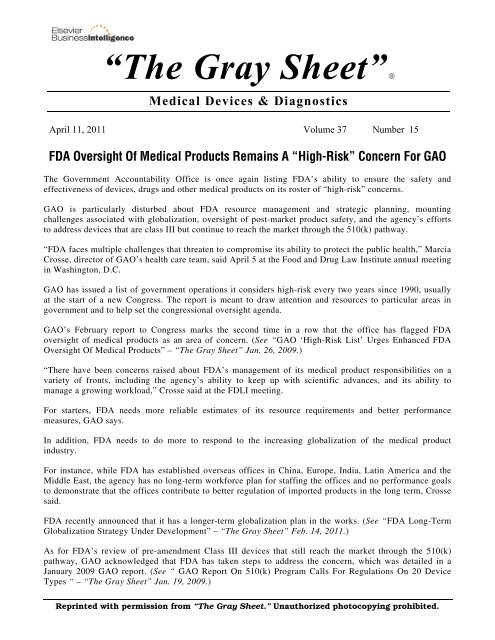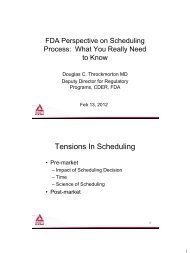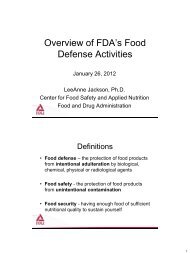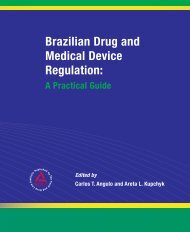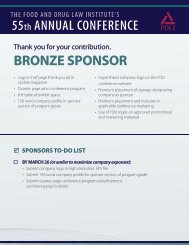FDA Oversight Of Medical Products Remains A "High-Risk"
FDA Oversight Of Medical Products Remains A "High-Risk"
FDA Oversight Of Medical Products Remains A "High-Risk"
- No tags were found...
You also want an ePaper? Increase the reach of your titles
YUMPU automatically turns print PDFs into web optimized ePapers that Google loves.
Reprint Article From “The Gray Sheet” 1“The Gray Sheet” <strong>Medical</strong> Devices & DiagnosticsApril 11, 2011 Volume 37 Number 15<strong>FDA</strong> <strong>Oversight</strong> <strong>Of</strong> <strong>Medical</strong> <strong>Products</strong> <strong>Remains</strong> A “<strong>High</strong>-Risk” Concern For GAOThe Government Accountability <strong>Of</strong>fice is once again listing <strong>FDA</strong>’s ability to ensure the safety andeffectiveness of devices, drugs and other medical products on its roster of “high-risk” concerns.GAO is particularly disturbed about <strong>FDA</strong> resource management and strategic planning, mountingchallenges associated with globalization, oversight of post-market product safety, and the agency’s effortsto address devices that are class III but continue to reach the market through the 510(k) pathway.“<strong>FDA</strong> faces multiple challenges that threaten to compromise its ability to protect the public health,” MarciaCrosse, director of GAO’s health care team, said April 5 at the Food and Drug Law Institute annual meetingin Washington, D.C.GAO has issued a list of government operations it considers high-risk every two years since 1990, usuallyat the start of a new Congress. The report is meant to draw attention and resources to particular areas ingovernment and to help set the congressional oversight agenda.GAO’s February report to Congress marks the second time in a row that the office has flagged <strong>FDA</strong>oversight of medical products as an area of concern. (See “GAO ‘<strong>High</strong>-Risk List’ Urges Enhanced <strong>FDA</strong><strong>Oversight</strong> <strong>Of</strong> <strong>Medical</strong> <strong>Products</strong>” – “The Gray Sheet” Jan. 26, 2009.)“There have been concerns raised about <strong>FDA</strong>’s management of its medical product responsibilities on avariety of fronts, including the agency’s ability to keep up with scientific advances, and its ability tomanage a growing workload,” Crosse said at the FDLI meeting.For starters, <strong>FDA</strong> needs more reliable estimates of its resource requirements and better performancemeasures, GAO says.In addition, <strong>FDA</strong> needs to do more to respond to the increasing globalization of the medical productindustry.For instance, while <strong>FDA</strong> has established overseas offices in China, Europe, India, Latin America and theMiddle East, the agency has no long-term workforce plan for staffing the offices and no performance goalsto demonstrate that the offices contribute to better regulation of imported products in the long term, Crossesaid.<strong>FDA</strong> recently announced that it has a longer-term globalization plan in the works. (See “<strong>FDA</strong> Long-TermGlobalization Strategy Under Development” – “The Gray Sheet” Feb. 14, 2011.)As for <strong>FDA</strong>’s review of pre-amendment Class III devices that still reach the market through the 510(k)pathway, GAO acknowledged that <strong>FDA</strong> has taken steps to address the concern, which was detailed in aJanuary 2009 GAO report. (See “ GAO Report On 510(k) Program Calls For Regulations On 20 DeviceTypes “ – “The Gray Sheet” Jan. 19, 2009.)Reprinted with permission from “The Gray Sheet.” Unauthorized photocopying prohibited.
Reprint Article From “The Gray Sheet” 2“We are aware that the agency has been taking a number of steps,” Crosse said. But of the remaining 20-some pre-amendment device types that <strong>FDA</strong> has yet to address, “only one final regulation has yet beenissued,” she noted, on dental amalgam.Crosse said she is scheduled to testify before Congress this week to provide an update and assessment on<strong>FDA</strong>’s progress since 2009.Getting <strong>Of</strong>f The <strong>High</strong>-Risk ListTo get itself off the high-risk list, GAO says, <strong>FDA</strong> must respond more vigorously to the identifiedweaknesses, such as by establishing a plan and timetable for assuring that high-risk medical devices arereviewed through the PMA process, rather than 510(k).GAO removes the high-risk designation when legislative, administrative and agency actions result insignificant progress toward resolving identified issues.<strong>FDA</strong> must demonstrate a commitment to addressing the problems, a capacity to address them and acorrective action plan, Crosse noted.“It’s in our interest and in the interest of every person in this room that <strong>FDA</strong> have the capacity, theplanning, the direction and the ability to manage its responsibilities to protect the public health,” she toldFDLI meeting attendees.<strong>FDA</strong>’s oversight of food safety also made GAO’s high-risk list this year. The high-risk list includes 30items in total, spanning numerous government agencies.The biennial “<strong>High</strong>-Risk” report is part of a GAO program to focus attention on government operations thatthe office identifies as high risk “due to their greater vulnerabilities to fraud, waste, abuse andmismanagement, or the need for transformation to address economy, efficiency or effectivenesschallenges,” GAO explains.“Perseverance by the executive branch in implementing GAO’s recommended solutions and continuedoversight and action by Congress are essential to achieving progress,” the report states.By Jessica Bylander© 2011 F-D-C Reports, Inc.; An Elsevier Company, All Rights Reserved.Reproduction, photocopying, storage or transmission by magnetic or electronic means is strictly prohibited by law.Authorization to photocopy items for internal or personal use is granted by F-D-C Reports, Inc., when the fee of $25.00per copy of each page is paid directly to Copyright Clearance Center, 222 Rosewood Dr., Danvers, MA 01923, (978) 750-8400. The Transaction Reporting Service fee code is: 1530-1214/11 $0.00 + $25.00. Violation of copyright will result inlegal action, including civil and/or criminal penalties, and suspension of service. For more information, contactcustcare@elsevier.com.Reprinted with permission from “The Gray Sheet.” Unauthorized photocopying prohibited.


